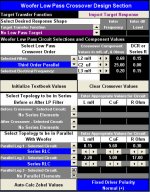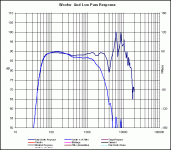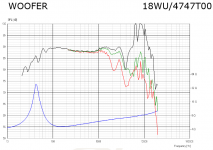This one passed me by .. Their 6.5" illuminator designed towards 3 way projects but looks like it may work well in a 2 way below 2khz. I realise theres a paper cone version etc but this one requires less bsc if any according to scanspeaks datasheet
http://www.scan-speak.dk/datasheet/pdf/18wu-4747t00.pdf
http://www.pearl-hifi.com/06_Lit_Archive/15_Mfrs_Publications/40_Voice_Coil/2010/2010_4_Apr.pdf
Scroll down for review/test
http://www.scan-speak.dk/datasheet/pdf/18wu-4747t00.pdf
http://www.pearl-hifi.com/06_Lit_Archive/15_Mfrs_Publications/40_Voice_Coil/2010/2010_4_Apr.pdf
Scroll down for review/test
Last edited:
Hi,
The German magazine HobbyHifi deemed it possible in a two way also if I remember it correct. It's really clean in the MLSSA up to 2kHz with low distortion. If my memory is wrong and like the Swiss cheese as normal, then our german friends here will be allowed a free whack on my head. I'm in Essen for the moment;o)
Peter
The German magazine HobbyHifi deemed it possible in a two way also if I remember it correct. It's really clean in the MLSSA up to 2kHz with low distortion. If my memory is wrong and like the Swiss cheese as normal, then our german friends here will be allowed a free whack on my head. I'm in Essen for the moment;o)
Peter
What goes on beyond 3khz is a bit odd, i guess its 'semi' breakup which is down to the cone material. Bit of a gamble to use as a two way perhaps, but it might be possible with an AMT such as the aurum cantus ast2560 (2nd/3rd)
One commercial design is crossing it at 3khz (too much imo)
One commercial design is crossing it at 3khz (too much imo)
If you are worried about baffle step then you could just go the DSP route, either full out active or a hybrid design.
The Illuminators are very very good drivers, and Scanspeak themselves market it as a woofer and not a midwoofer, when paying that much for a driver I'd recommend you to use it optimally... so I'd still recommend you to get the paper version =)
Zaph has tested both: Zaph|Audio and in Zaph|Audio. They measure similar apart from the breakup but another point is that high order distortion rise a lot from 1-2 khz on the alu woofer but not on the paper version, which is another one in the favor of paper as a midwoofer.
The Illuminators are very very good drivers, and Scanspeak themselves market it as a woofer and not a midwoofer, when paying that much for a driver I'd recommend you to use it optimally... so I'd still recommend you to get the paper version =)
Zaph has tested both: Zaph|Audio and in Zaph|Audio. They measure similar apart from the breakup but another point is that high order distortion rise a lot from 1-2 khz on the alu woofer but not on the paper version, which is another one in the favor of paper as a midwoofer.
Main issue is availability where I live in asia; the local dealers dont carry the paper version. If I can cross it at around 1.5khz 3rd order maybe i can largely avoid the possible issues ..also i'm not good at putting together complicated crossovers hence why i tend to go for drivers with a rising response for bsc
They measure similar apart from the breakup but another
point is that high order distortion rise a lot from 1-2 khz
on the alu woofer but not on the paper version, which is
another one in the favor of paper as a midwoofer.
The distortion in that region is a function of cone breakup.
8,5 kHz/3=2,83 kHz; 6,5 kHz/3 = 2,16 kHz for 3rd order
distortion. Low pass all of these and the distortion will go
away.
Of course they are, but I disagree. With an electrical crossover those distortions should stay the same. If it was an acoustical crossover then yes, they would disappear but sadly that isn't the case here.The distortion in that region is a function of cone breakup.
8,5 kHz/3=2,83 kHz; 6,5 kHz/3 = 2,16 kHz for 3rd order
distortion. Low pass all of these and the distortion will go
away.
To be honest, the paper version has a distortion peak at around 800hz according to the klippel test on techtalk. Which is worse?
So Ollboll what you saying is that even if overall output is reduced by electrical roll off, the audible distortion isnt reduced/stays the same?
So Ollboll what you saying is that even if overall output is reduced by electrical roll off, the audible distortion isnt reduced/stays the same?
Last edited:
Blimey, what a horrible metal woofer for the DIYer! A considerable crossover undertaking I'd say. All that cone breakup. 4th order required if this SEAS construction is anything to go by.
TJL-2W
Troels might give it a go, but for people equipped with just a few tools it makes no sense. And really, I really don't know why people throw so much effort at this sort of design anyway. I never like 6" bass. It just seems the worst of all worlds. A three way makes far more sense when spending big bucks.
TJL-2W
Troels might give it a go, but for people equipped with just a few tools it makes no sense. And really, I really don't know why people throw so much effort at this sort of design anyway. I never like 6" bass. It just seems the worst of all worlds. A three way makes far more sense when spending big bucks.
Attachments
Yes, it's hugeeee! Better a 4" or a 5"I never like 6" bass. It just seems the worst of all worlds. A three way makes far more sense when spending big bucks.
Of course they are, but I disagree.
With an electrical crossover those distortions should stay the
same. If it was an acoustical crossover then yes, they would
disappear but sadly that isn't the case here.
If they are, why disagree?
You measure a driver say at 2,83V rms and the distortion is 0,5%
at 1 kHz. The voltage of the distortion is 0,005*2,83=0,014 V.
Now let's increase the voltage for a new measurement to 4 Vrms.
Assume the distortion is still 0,5 % at 1 kHz, only now 0,005*4=0,02V.
The 0,02 V of distortion is now 1,42 times greater than the 0,014 V.
That increase comes from the measurement voltage increase.
Now if we could set the measurement voltage to 4 Vrms only for
frequencies below 1 kHz and the area around 1 kHz to 2,83 V
(which is what low pass filter does), wouldn't the distortion
measurement of 1 kHz be lower than in case of 4V without any
filtering?
Blimey, what a horrible metal woofer for the DIYer! A considerable crossover undertaking I'd say. All that cone breakup. 4th order required if this SEAS construction is anything to go by.
TJL-2W
Troels might give it a go, but for people equipped with just a few tools it makes no sense. And really, I really don't know why people throw so much effort at this sort of design anyway. I never like 6" bass. It just seems the worst of all worlds. A three way makes far more sense when spending big bucks.
not claiming to be an expert but did you see what Lojzek kindly supplied at the beginning of the thread? It didnt look too bad to me, quite a smooth roll off if keeping the x/o point low
I'm guessing that bump around 1.5khz is kind of useful as it needs to be rolled off even earlier
Last edited:
Thing is, Bill, a fourth order crossover with a notch takes some serious modelling and building. I have no doubt that metal drivers are capable of being very revealing. They have a very pistonic sort of response, and very flat power response. But also some horrible breakup issues.not claiming to be an expert but did you see what Lojzek kindly supplied at the beginning of the thread? It didnt look too bad to me, quite a smooth roll off if keeping the x/o point low
I'm guessing that bump around 1.5khz is kind of useful as it needs to be rolled off even earlier
I'd question whether you should embark on such a design as a simple DIYer. It also leads you to a low 2kHz crossover, which is quite demanding on tweeters. Never mind fitting in about 20 crossover components.
For someone who admits to being a bit baffled by mere bafflestep, this is going to be a huge project. You gotta wonder why Scanspeak don't publish a reference design for this driver. I suspect they are just trying to keep up with the SB Acoustics Satori designs.
Like I said, a three way just keeps the drivers working within their comfort zones. It's not hard. SEAS-3-Way-Classic
- Status
- This old topic is closed. If you want to reopen this topic, contact a moderator using the "Report Post" button.
- Home
- Loudspeakers
- Multi-Way
- Scanspeak 18WU/4747T00 in a 2 Way?


